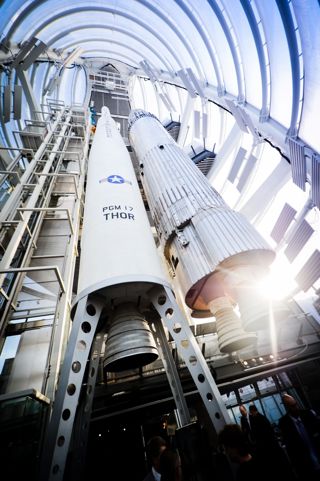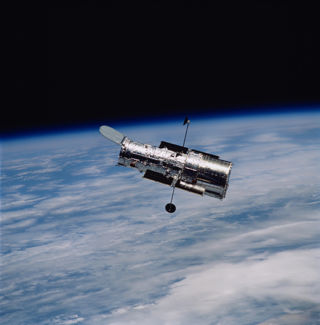
What Makes Leicester the Place for Space?
- 3rd Mar 2020
- Author: Alex Evans
The UK’s National Space Centre in Leicester first opened to the public in 2001 and has since been attracting visitors from all over the world - but why build it here in Leicester?
Well, you might not know it, but Leicester is one of the most active cities for space research in the world and has been contributing to the exploration of space for over 60 years.
Leicester’s Early Launches
Starting in the early 1960s, physicists at the University of Leicester first began dabbling in space research.
These pioneers were focused on developing important x-ray technology that would be used on board both European and American satellites – including Ariel 1, the UK’s first ever satellite to be launched into space.
While the Americans and Russians were busy building rockets designed to take humans to the Moon and back, Leicester’s scientists were interested in rockets of a different kind.
In 1961, the University of Leicester became involved in the UK’s revolutionary Skylark sounding rocket project and helped to launch scientific instruments into space, allowing researchers to measure solar X-rays without interference from the Earth’s atmosphere.
In the end, the Skylark rockets were launched over 440 times until the project was shut down in 2005 because orbiting satellites had become a much more efficient method of collecting information in space.
Terrific Telescopes
Leaping forwards to the 1990s and the University of Leicester’s space researchers have been busy developing exciting new technologies that allow us to see further out into the universe than ever before.
Hubble Space Telescope
Not long after the famous Hubble Space Telescope was launched in 1990, scientists quickly realised that the lens of the telescope was faulty after the Hubble started sending back blurry photos.
NASA astronaut Jeff Hoffman, who is a University of Leicester alumnus, was sent up in 1993 as part of the STS-61 space shuttle mission to make vital repairs to Hubble and successfully fixed the problem with the wonky lens.
Hoffman flew 5 space missions with NASA in total, and on his first visit to space he took along a few Leicester mementos – including a pennant from the Lord Mayor’s Rolls Royce and a beer mat from a pub in the Leicestershire town of Oadby!
Since his retirement as an astronaut, Jeff has been a visiting professor at the University of Leicester’s physics department since 2008 – teaching the next generation of space scientists and engineers.
James Webb Space Telescope
Hubble isn’t the only space telescope that has a place in Leicester’s history, and in fact, the University of Leicester has been very involved in Hubble’s successor – the enormous James Webb Space Telescope, which was launched on 25 December 2021
Built with 18 individual hexagonal mirrors which work together to provide 15 times the coverage as Hubble and a sunshield the size of a tennis court, the JWST uses the MIRI infra-red camera technology developed at the University of Leicester to search for the redshifted light of distant galaxies, newly forming stars, and faintly visible comets as well as objects in the Kuiper Belt.
X-ray Explorers
XMM-Newton X-ray Telescope
In the 1990s, Leicester’s speciality in x-ray astronomy was put to the test as they were tasked with designing an epic camera for the European Space Agency’s new X-ray telescope called XMM-Newton that was to be launched in 1999. This camera was literally EPIC, standing for the European Photon Imaging Camera.
The telescope focused astronomical x-rays using a series of very long and heavy mirrors to a point where they could be detected by a charge-coupled device (CCD), analysed and converted into digital images. By searching the skies for sources of x-rays, Leicester’s tech on board the XMM-Newton has enabled us to investigate the auroras around Jupiter’s poles, distant stars being devoured by black holes and mysterious blinking pulsars in the night sky.
Swift Telescope
Wanting to get in on the action, it wasn’t long until NASA contracted Leicester to build cameras similar to EPIC for their Swift satellite that was launched in 2004, with the mission of studying elusive Gamma-ray Bursts, the most energetic explosions in the known universe! Swift has successfully observed these GRBs as far as 13.14 billion light years away, and has also acted as an early warning system for telescopes to study a brand new supernova which was described as the Rosetta Stone for astronomy.
As well as designing and building these special space-cameras, the University of Leicester has also been the site of the XMM-Newton and Swift data centres, where the important information captured by these telescopes is analysed and exciting discoveries about our universe are made!
Leicester on Other Worlds
Mercury – BepiColombo
One of the most exciting active space exploration missions is ESA’s BepiColombo mission to the planet Mercury, which they are collaborating on with the Japanese Space Agency, JAXA. Mercury is the least explored of the inner planets in the solar system and BepiColombo will only be the third ever mission to venture out there, making this one quite a big deal.
After a whopping 7-year flight and eventual arrival at Mercury in December 2025, BepiColombo will split into three separate spacecraft, with the aim of studying the planet's composition, exosphere and magnetosphere. ESA also hope to determine whether there is water ice hidden in permanently shadowed craters at Mercury's poles. But where does Leicester fit into all of this?
One of the key tools in BepiColombo’s arsenal is the lobster-inspired Mercury Imaging X-ray Spectrometer, or MIXS for short, which was built at the University of Leicester in partnership with researchers from Germany, Spain and Finland, who also worked on another instrument for BepiColombo called SIXS. Fun fact: in Finnish, this spelling of “mixs” actually means “why?” and “sixs” actually means “that’s why.”
Mars – Beagle 2
Move over Mercury, the planet on everyone’s mind right now is Mars – and Leicester has also played many roles in the ongoing exploration of this exciting world and the quest for extra-terrestrial life.
One such mission was the infamous Beagle 2 lander, whose goal was to look for signs of life on the surface of Mars. Unfortunately, after a successful landing on the surface of Mars in 2003, all communication with Beagle 2 was lost – and it wasn’t until 2015 that NASA’s Mars Reconnaissance Orbiter was able to locate and snap some photos of the lander! Did you know the control centre for Beagle 2 was actually the National Space Centre? In this video, we explore the mission on its 20th anniversary.
More recently, the University of Leicester’s Professor John Bridges has been an active member of NASA’s very successful Curiosity rover team.
ExoMars
NASA aren’t the only ones using robots to search for signs of life on Mars. The European Space Agency’s ExoMars Mission – short for Exobiology on Mars – will be sending a rover of their own in 2020. The rover is named after Rosalind Franklin, a brilliant English scientist whose research contributed to the discovery of the structure of DNA– the building blocks of life here on Earth! And just maybe, on Mars too.
Part of the rover’s mission is to drill down deep into the Martian soil and analyse its chemical contents for signs of biological activity using a Raman spectrometer – which has been developed collaboratively between the University of Leicester and other researchers in Spain, France and Germany.
The Rosalind Franklin rover has a planned launch date in 2028, and you can bet that we here at the National Space Centre are very, very excited about seeing this part Leicester-built robot drive around on another planet!
Full reference / credits:
(Banner Image) The Thor Able and Blue Streak rockets inside our rocket tower. Credit: National Space Centre
(1) Skylark inside our rocket tower. Credit: National Space Centre
(2a) The Hubble Space Telescope in low Earth orbit. Credit: NASA
(2b) Jeff Hoffman's Astronaut Portrait. Credit: NASA
(2c) An artist's impression of the James Webb Space Telescope. Credit: NASA
(3a) An artist's impression of XMM-Newton. Credit: ESA
(3b) An artist's impression of the Swift Telescope. Credit: NASA
(4a) An artist's impression of BepiColombo approaching Mercury. Credit: ESA
(4b) The MIXS instrument build by the University of Leicester. Credit: University of Leicester
(4c) An artist's impression of Beagle 2 deployed on the surface of Mars. Credit: ESA
(video) The Rosalind Franklin rover. Credit: ESA https://www.youtube.com/watch?v=aj7xNrbfCKw










